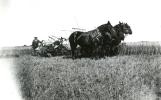1
In this section are some of the other tools and equipment used on a typical farm or homestead.Many of the larger pieces of equipment, such as seeders, harrows and discers were first pulled by horses or oxen, later by moving steam engines such as the type Case built, and finally with kerosene or gas tractors.
Firewood and lumber for building was often acquired personally, some cut by hand and some by machine.
In the following pages, we show photos of men working the land with various farming equipment, the manual and mechanical splitting of firewood, hauling of timber by horse and wagon, and some of the first saw mills run in our area.
Following this general section are more specific equipment sections, such as tractors, plows and threshers.
3
Alfred Wilbright is clearing poplar trees from his land in this photo.The horse's collar is hooked up to a bar with chains. The chains would be wound around or attached to a tree stump somehow, and Alfred would guide the horse to pull out the stump with the horse's brute strength.
One would need a strong, willing animal to help with this type of job.
5
James Reubon Brackney harrowing fields in 1919.This is a wooden harrow, with steel teeth, and is used to pack the ground, after plowing, in preparation for seeding.
James would walk behind the harrow, guiding his team of horses.
7
After harrowing, came seeding. The equipment in this photo is a very large seeding outfit.Seeders were also called 'drillers' by many farmers.
9
Sylvester Suttley cutting grain with a binder. Binders cut a left-hand swath in the grain field.In the late 1800's and very early 1900's, reapers were used to cut grain, and the farmers hand tied their bundles or forked them onto a rack to haul away.
Around the teens to early 20's, small binders were developed which both cut and bound the grain. In the 30's and 40's, larger binders were developed, making the job even easier. The swather took over the job of the binder in later years.
This binder here is one of the smaller, early ones.
11
Two women taking a break from work. Behind them is an overhead stacker.The stacker was used to hoist large stacks of hay or grasses from the ground to the top of huge stacks.
13
This woman is in charge of directing a horse.When she leads the horse forward, it pulls a cable which is attached to the stacker. This hoists the hay up onto the hay pile.
(see next photo)






